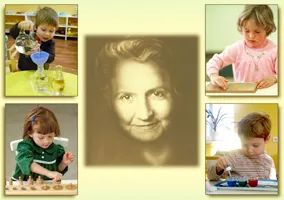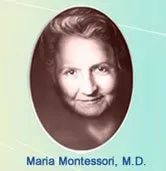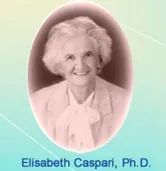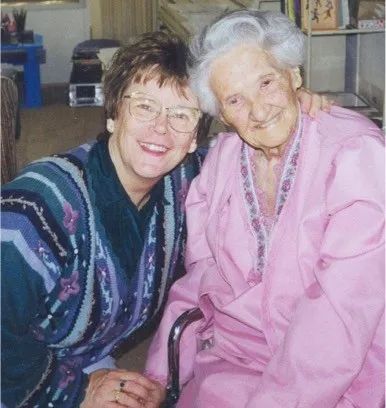Part 2: Maria Montessori: Groundbreaker, Method Maker
The Method (Continued…)
"I observed little children; I sensed their needs; I tried to fulfill them: they call that the Montessori Method". - Dr. Maria Montessori

Maria Montessori’s educational method starts with a carefully prepared environment. Based on her brilliant insights into the way children really learn, Maria developed hands-on materials that appeal to, and correspond with the child’s developmental stages. Within the prepared environment, materials and lessons fall into four main avenues of learning: Practical Life, Sensorial Development, Development of Language, and Early Preparation of the Mathematical Mind.
As the name implies, Practical Life lessons develop skills that are useful in everyday life. In addition to gaining confidence through a budding sense of independence, children develop small and large motor skills, coordination, and an ability to maintain concentration. Practical Life lessons also teach basic social skills, manners, and courtesy. Lessons in Practical Life include things like sweeping, hand washing, buttoning/zipping, and pouring water, as well as “grace and courtesy” lessons like proper greetings, introductions, and cultural customs such as hand shaking.
Sensorial Development lessons teach by providing hands-on activities and stimuli for the five senses: sight, sound, smell, taste, and touch. In Montessori classrooms, these materials include things like the classic pink tower blocks, long rods, bells, color palettes, sand paper letters, and more. These lessons are not only a “feast for the senses,” but they also prepare the child for more advanced lessons in math, science, and music.
Development of Language lessons start with basic spoken language, vocabulary, and phonemic awareness. Children in the Absorbent Mind Stage (birth to about age six) naturally and quickly learn spoken words and their meanings. Next, they learn letter shapes and their corresponding sounds (see phonemic awareness and alphabetic principle.) Before you know it, children are building words with letters, and then sentences with words. Montessori’s hands-on, language lesson materials include things like sand paper letters, phonics cards, and the movable alphabet.
Early Preparation of the Mathematical Mind involves using tangible materials to teach young children the abstract concepts of math. The Montessori Method breaks mathematical thinking down into steps: quantity as a visible and physical object, quantity as a number, names of numbers, numbers as symbols, symbols as quantities, and series of numbers as a progression of quantity. Children learn the fundamentals of numerical thinking, which in turn, lays the foundation for more advanced mathematical concepts. Montessori’s mathematical materials include the classic golden beads, blocks, rods, and tactile number cards.
Maria the Unstoppable
Maria continued to develop her educational method and to teach others to do the same. She started many schools, both for children and for future Montessori teachers. She established a whole new system of education, one based on the way children really develop. She wrote numerous books and gave lectures all over the world to spread her message: there is a better way to educate our children! Innovative thinkers, scientists, and educators from across the globe, sat up and took notice of this irrefutably effective approach to teaching. Montessori  schools popped up all over Europe and the United States.
schools popped up all over Europe and the United States.

Unfortunately, during times of war and political strife, important issues such as education are often forced into the background, and Montessori’s life spanned two world wars. In 1940, Maria was lecturing in India when hostilities between Italy and Great Britain broke out. Maria had no choice but to remain in India. Ever the opportunist, Maria continued to teach the Montessori Method until the end of the war.
Remarkably, Maria met Dr. Elisabeth Caspari, another European, female doctor who, with her husband Charles, was also stranded in India. The two women became close friends, as well as mentor and apprentice. During the next four years, Elisabeth trained extensively in Maria’s groundbreaking educational methods. After the war, Maria returned to Europe, bur Elisabeth and her husband travelled to America to continue to spread the message of Montessori.

In 1979 Elisabeth Caspari met Mary Ellen Maunz. The two became fast friends and spent many years teaching Montessori together. They began collaborating on what  would eventually become Age of Montessori, a truly authentic training program based on the ideology and message of Maria Montessori herself.
would eventually become Age of Montessori, a truly authentic training program based on the ideology and message of Maria Montessori herself.

Maria Montessori never stopped her work to help children. She also continued to campaign for women’s rights, and was a champion of spreading peace through education. During her life, Maria received honors in many nations and three Nobel Peace Prize nominations for her brilliant work. Maria Montessori died in a peaceful garden on May 6, 1952.




















